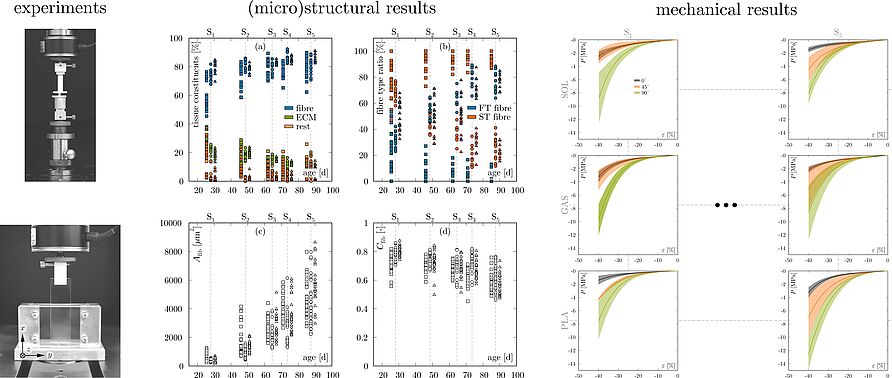In order to meet the requirements of body weight and height and the associated changing tasks and movement patterns during the growth of living bodies, significant changes in the skeletal musculature occur during this phase. In this study, the age-dependent (between 21 and 100 days) mechanical and microstructural tissue behaviour of the calf musculature, consisting of soleus muscles (SOL), gastrocnemius muscles (GAS) and plantaris muscles (PLA), was examined. To this end, cubic muscle tissue samples were examined using axial and semi-confined compression experiments. In addition, the essential muscle tissue components (muscle fibres, extracellular matrix, remaining components) were analysed. In a final step, these results were linked to morphological properties of the animals and muscles (animal mass, muscle mass, tibia length). Interestingly, the mechanical properties of the individual muscle types hardly differ from each other during growth, while both the morphological and microstructural properties change significantly. Thus, a clear increase of all morphological parameters (animal mass by 850%, muscle mass by 1000% (SOL), 1183% (GAS) and 1050% (PLA), tibia length by 235%) can be seen. In comparison, the microstructural parameters show a less consistent trend. The proportion of muscle fibres in the tissue cross-section increases by about 138% in the SOL, whereas the fibre proportion in both the GAS and PLA increases by only 109%. Consequently, the ECM proportion in the tissue cross-section decreases by 48%, 58% and 52% for SOL, GAS and PLA. Overall, the data obtained her e provides a deeper understanding of muscle growth and, in particular, of different muscle types that have different functions inside the calf. On the other hand, these data represent a good and comprehensive basis for later model developments.
M. Böl, K. Leichsenring, S. Kutschke, F. Walter, T. Siebert
Age-dependent properties of the rabbit calf musculature - relationship between mechanic and microstructure
Journal of the Mechanical Behavior of Biomedical Materials, 168, 107008, (2025) [Link]

